For blogger MW, re: JONES STORE. I am working on an article for Union Staton and for my book about the Jones Store train. Can you help me find out any information, like when it debuted at Jones or anything, actually. I have a pretty good handle on the lineage but more information would be great! Roy Inman www.royinmanphotos.com
Monday, October 18, 2021
Tuesday, November 10, 2009
Union Station and Me epilogue
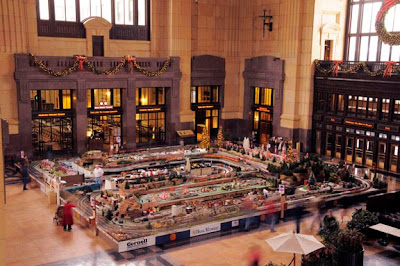
From "Trains are too blue-collar for Union Station" to the largest temporary model train layout in America, the Holiday Village. It only took ten years to get from there to here, he said with more than a hint of exasperation.

One of the plasterers signs the final rosette to be installed.

If you are wondering how a 115-pound woman can carry a lamp post, it is because the lamp post is made of foam. The light illuminated. The post and lamp were part of dozens of auctioned props from the two movies shot before the restoration.

Actor Gary Sinise played Harry Truman, Diana Scarwid played Bess Truman in the made for TV movie "Truman" much of which was shot at Union Station.

The North Waiting Room was propped to look like it did in the 1930's for Robert Altman's movie, "Kansas City."

A tight shot of the Holiday Village layout.

The Grand Hall was scrimmed off during part of the shooting of the movie "Kansas City."
Epilogue:
I think I know.
Back in the 1980's the now defunct Halls Station model train shop was located inside Hall's department store. According to the founder and super-guru of the shop, Norman Allen, one day after a local train show a family showed up to gawk at the train layouts in the store. The group was, in his words "extremely blue-collar, and maybe a little white trashy." The kids were runny-nosed and loud, the father had a missing front tooth and wore coveralls; mom was quite obviously going to be one again. As luck, or rather misfortune would have it, Don Hall was in the store that day, and he was watching the family. After they left, Don came over to Norman and said "These are not Hall's customers."
Shortly thereafter Hall's Station was moved to a freestanding location where it remained until it's discontinuation in June of 2009. Don Hall was saying, in other words, "keep the riff-raff out of our high-end department store."
Making the connection to Union Station is all mine, and maybe I am adding 2+2 and coming up with three, but here goes.
At least one Hall's Foundation representative was on the Union Station board of directors from the first.
Just after the station re-opened, a number of train clubs came together and tried to establish a model train presence at the station. I was involved with the group for the 4.5 years of its existence. IMO, we spent far too long and late into the night, on details of the organization and not enough time on actually planning train layouts. In any event, through three administrations, we never were able to get anything moving.
We should have realized that it was a futile attempt because Andy Scott told us early on that some on the board felt, and I quote, that "Trains are too blue-collar for the station." How's that again? I know, I know, it sounds preposterous, but those were Andy's very words. Never mind the fact that the only reason the building exists is because of trains...well, don't get me started.
So, here we have the incident at Hall's years earlier, and we have a Hall's Foundation representative on the board (I will not mention who), and we have an attitude as espoused above. My conclusion is that Hall's Foundation (which had already sunk a bundle into the station) was the prime motivator of the "down trains" approach.
That attitude changed when station CEO's finally, FINALLY figured out that it is about trains. Sean O'Burne was the first, albeit very temporary, CEO to get it. Andi (yes, with an "i") Udris continued the trend toward trains. And now, THE most popular feature of Union Station is the annual Holiday Village multi-scale train layout. It has become a Kansas City holiday tradition in just five years.
Not that trains will pay the bills, although if things had been handled differently, if the rail museum had truly been world-class, trains could have helped more with finances.
Where does the station go from here?
Will it be boarded up to the general public, a plywood hallway erected to allow Amtrak passengers to board and another plywood hallway to funnel post office customers to the counters?
I do not believe that will ever happen. Some foundation or individual will always come forth with the rescue funds just in the nick to keep the station afloat. I hope.
It will require really, really wise management and, of course, the elephant in the room, public money. Without both, Union Station will remain just a promise without fulfillment.
#
Wednesday, November 4, 2009
Union Station and Me VI, final entry

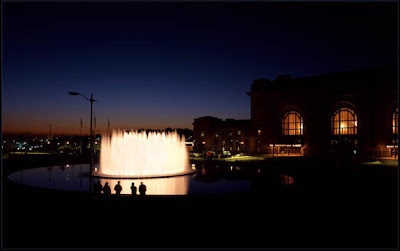











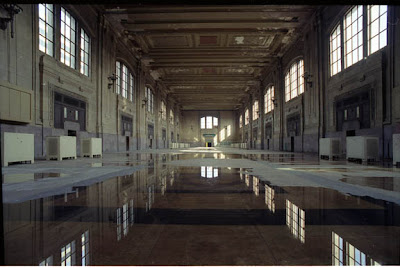

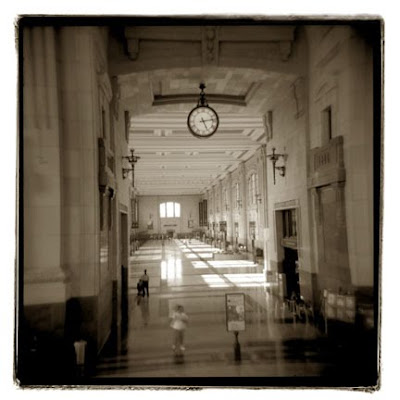




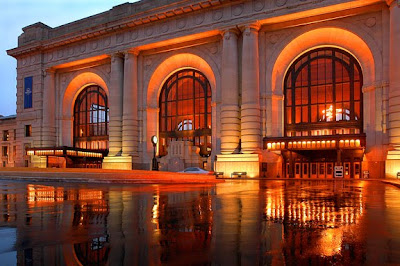



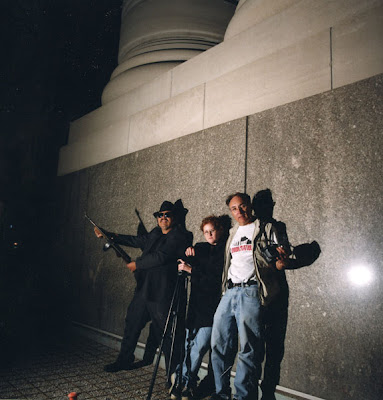




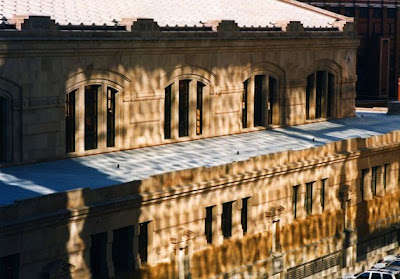













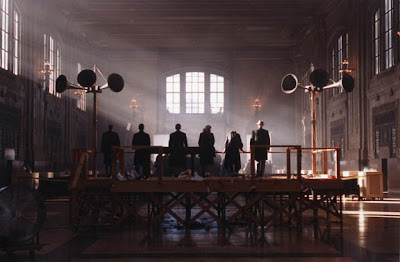





"It's stupendous, colossal, gigantic and superb."-Howard Simpson, former Union Station employee, on the occasion of the station's grand re-opening Wednesday, November 10, 1999. From the "Kansas City Star", Thursday, November 11, 1999©
The rain drops rolled off the wide brim of my Tilley Hat, and everything started coming back, bittersweet emotions enveloping me like the surrounding monochrome afternoon...
_________________________________
From the very beginning, Andy Scott talked about creating a Union Station book for the grand re-opening, and in fact pointed out on many occasions photo opportunities that would "...probably work well in our book." He would pass along ideas such as workers pausing at lunch amongst all the restoration debris, signatures and notes written on a wall by actors from the old Circle Theatre that was in the station for a while, and even made it possible for me to have a key to the chain link fence that surrounded the perimeter early on. I appreciated that, because then I could get on site during the weekend and could use friends and relatives as grips-people who had REAL jobs and couldn't help me during the week.
So it went for years. I shot everything, whether it moved or not. There were even a few overnights, although I think Andy did not know about those. I will say that he "got it" about the importance of photography. In fact he told me once "What you are doing is just as important as what the workers are doing. They are giving the station new life, and you are recording it."
It became a near-obsession, although to talk to my wife, there should be no "near" in the phrase. (I was gone a lot). To my mind, I was embarked on a photo documentation of historic proportions, vaguely similar to that of O. Winston Link's photo record of the last days of steam engine operations in America, on the old Norfolk and Western Railroad. Both projects centered around a train theme, both took about five years, and both were done with little or no compensation. Both involved the exposing of thousands of images, all on film. Not to compare his classic and monumental works to my efforts. He was photographing subjects that were literally being scrapped. He was using multiple flashbulbs in huge reflectors, all hard-wired, and was burdened with the cumbersome technology of the 1950's. His results were amazing.
And yet, I felt that in a sense what I was doing was almost as significant.
Consider:
-When it was completed in 1914, Union Station was the third largest rail terminal in America. First was the now-destroyed Pennsylvania Station in New York, then Grand Central Terminal, also in New York. Now, Union Station is the second largest train station in the country. Bigger than any in Chicago, Detroit, Cincinnati or Los Angeles.
-Someone estimated that half of all United States service men and women in WWII passed through Union Station Kansas City. At one time, nearly 300 passenger trains arrived and departed the station in a single day.
-The first two streamlined trains in US history were photographed together only once, at Union Station, because they both began their journeys there.
-The station was a local and regional transportation hub, and because of its strategic central location was tied in with the nationwide network of rail transportation.
Things seemed on track, as it were, for my photos to be a primary part of the Union Station Kansas City book, to be published by Union Station.
__________________________________________
One day in 1998 Andy asked me if I knew how to go about getting this book published. "Yes I do, Andy," I replied. "I have been involved directly and indirectly in the production of more than a dozen books and I will be happy to tell you everything I know."
"So where do we start?" he wanted to know.
I suggested talking with Jane Mobley at Jane Mobley and associates. I had worked with Jane and her excellent staff on a number of books and knew they would be a perfect match.
Then, late in 1998, I had not heard anything further about the book from either Andy or Jane. So I called Jane.
She uttered the words I shall never forget: "The Star got the book."
Could have knocked me over with a feather.
I was, in no particular order, stunned, angry (difficult to say in mere words just HOW angry I was), felt betrayed, and on the verge of destroying all my negatives from the station coverage so far.
So incensed was I that I did not shoot any photos at the station for about two weeks.
Then, as I cooled off I decided that the project was bigger than any of us, and that the station might stand another 1,000 years. Like the rock group Kansas said, we are just "Dust in the wind." And we never did have anything in writing, no contract. My error.
I went back to photographing, avoiding any contact with Andy as much as possible.
It seems that Andy Scott had invited both Jane and Jeff Spivak, Kansas City Star writer, to lunch to discuss the book project. Andy was so naive about publishing that he apparently didn't even realize he was talking to two potential competitors for the same job at the same time!
The primary reason The Star got the book was because it would not cost the station anything for production, nor would it require much of Andy's time. Jeff and Star editors would do virtually all of the work. Of course, they also had full control of the project. JMA would have charged the usual fees to produce and publish such a volume.
Jeff took some time off to finish the book, much of which was a compilation of his stories that had already run in the Star. His beat was Union Station, so he had considerable inside knowledge. There was a lot of new material as well, and it was an excellent production, albeit sans any of my photos. I hold no bad feelings about Jeff, and consider him a friend. I bought one of the books and he kindly signed it for me. What the heck, I might have done the same thing as he, if our situations were reversed.
It was, after all, Andy Scott who had hung me out to dry.
Even after what was one of the bigger disappointments in my checkered photography career, I continued to photograph at Union Station, long after the grand re-opening November 10, 1999, and continue to shoot to this day. Over the years, I have tried other venues to get the book published, but to no avail.
The next project I took on was the restoration of the old REA (Railway Express Building) immediately west of the station. The United States Postal Service had struck a deal with the station to move into the old space after it was renovated. One of the executives at the station suggested that I turn in a bid to photograph that project, which I did. She sent back the bid with the hand-written notation: "Looks good, except that you aren't charging enough." So I re-submitted it, doubling the original amount. All seemed well, until she got fired. By now I had already shot a year's worth of photos. Things became so convoluted from that point, that I won't even try to unravel it all here. Suffice to say that I was, in that case, promised some compensation but the station reneged.
Then there was the Henry R. Bloch Memorial Fountain project, which I did on a pro bono basis. Followed by the Amtrak space restoration and passenger platform construction.
It all seemed like a good idea a the time.
Today I am surrounded by more than 70,000 images of Union Station, shot with cameras ranging from 4x5 view to panoramic to fish eye, and more recently, with digital equipment. Most of these photos have never been seen, which IMHO, is the public's loss. After all, anyone who paid sales tax in most counties in the metro area after the Bi State initiative helped finance the restoration. And I saw and photographed moments that no one else except for an assistant or two, ever saw.
After the book deal with the Star went down, I wanted to run into the Union Station Assistance Corporation offices and yell at the top of my lungs "But wait! You don't understand! This building contains the history of how a dusty little hamlet known as the City of Kansas grew into a metropolis of more than 2,000,000 souls. The station is tied with the history of the first rail bridge across the Missouri, which gave our town the advantage over Leavenworth, which was larger at the time. We now had the railroad. And because we now had the railroad, we were tied in with the influential and prosperous Eastern banks. And because of all that, Union Station and Kansas City were a part of helping make America the most powerful nation on Earth, and by extension, Union Station and Kansas City influenced what happened around our planet. And I have images that help tell this story. It's not about me, it's about the station. Don't you see?"
No, they did not see.
I had done the best I knew how. Others would have done better.
I do have this fantasy, though. Someday, maybe 50~100 years from now, the Steven Spielberg of the day will make a film that tells of the critical importance of the railroads, and their great stations, to the United States and the rest of the world. And maybe, just maybe, someone will be poking around in the ruins of Lenexa, KS and will find a bunch of dusty CD's with images of Union Station.
And maybe, just maybe, a few of those photos in the film will be mine.
Thanks to all who have stuck with me, and
Via con dios.
Roy
The photos:
An attempt at getting creative...NYE 1999.
February ice shot.
Night image featuring the Bloch Fountain.
Another snow scene.
Mug shot of the iconic clock. Shot with a Hasselblad Flex body, BTW.
I kind of liked the multi-colored light effect in the snow.
Probably my best interior, story-telling photo.
Gorgeous late afternoon light streaks across a now-hidden staircase.
Shows how the work lights were strung.
A Polaroid manipulate photo of one of the two round windows at the station
Even the station parking lot makes for good pictures.
Two pano images from opening day, November 10, 1999.
NYE, 1999. Fireworks were set off behind the Liberty Memorial as well as behind the station.
The first photo I shot of the restoration. The leaky roof allowed water to collect in the North Waiting Room (now Festival Plaza) after a rain.
My cheese shot at echoing the Union Station massacre in 1937. Rented a Thompson sub machine gun (barrell plugged), used brother George, who happened to have the correct hat and suit.
B&W sepia Holga image. On 120 film, no less.
Another view, same direction, but with shot digital instead of film.
Beam particles of light on C level before the restoration.
Whoops! A different crop of the shadow shot. Couldn't figure out how to delte it....
Early April image.
Rain photo.
Your basic June day post card shot.
Early morning light on the knuckle.
REA building before the restoration.
George, Ariana and I at the site of the shadow shot.
Bill Ehlers, master painter at work on the ceiling. I am reminded of Michael Angelo, Jesus on the Cross; you know, self-sacrificing stuff.
Only one guy on the plaster crew was small enough to fit into the space behind the ceiling sculptures, and he got a handshake for all the time spent in those cramped quarters.
Fish eye shot of one of the big windows.
If you look closely, you can barely make out the signature of Jarvis Hunt, station architect. It was found on a piece of the ceiling removed during the restoration.
Next two are just scenic shots I like.
This photo shows new wall pieces to be attached in what is now Pierpont's Restaurant.
Holidays at Union Station.
The ceiling during the restoration.
The only redeming quality of the building constructed smak dam next to the station is that its windows sometimes relfect an interesting light on the old rail terminal.
Miles and miles of new cables were installed at the station during the restoration.
It was common for workers to be busy on more than one floor at a time. This allowed for the occasional spectactular photo op.
Craftsmen in Lincoln, NE finish pieces of the new station roof, a fiberglass/concrete fusion material.
One Christmas Eve, brother George got mischevious and fitted one ring on one of the chandeliers with multi-colored lights and we plugged them in. Don't tell Andy...
Photo showing workers finishing up the roof.
The west baggage tunnel was long, dark and mysterious. It enabled baggage to be off loaded from trains, conveyed down an outside elevator, shuttled down this passageway and finally to be moved upstairs to the claim area.
A digitally manipulate image from a film negative.
The chandeliers were removed for restoration, and in this photo one can get a good idea of their relative size. St. Louis Antique Lighting brought them back to life.
A scene from one of two movies shot afte the station was opened for restoration, but before much work had been done.This is from the HMO movie "Truman," as in Harry.
One of the workbenches on C level before the restortion.
Whoops! Another one I couldn't delete...
The new Amtrak platform.
Boy, your guess is as good as mine... I will wonder forever what is meant by this scribbling.
Early ceiling work.
Subscribe to:
Posts (Atom)

